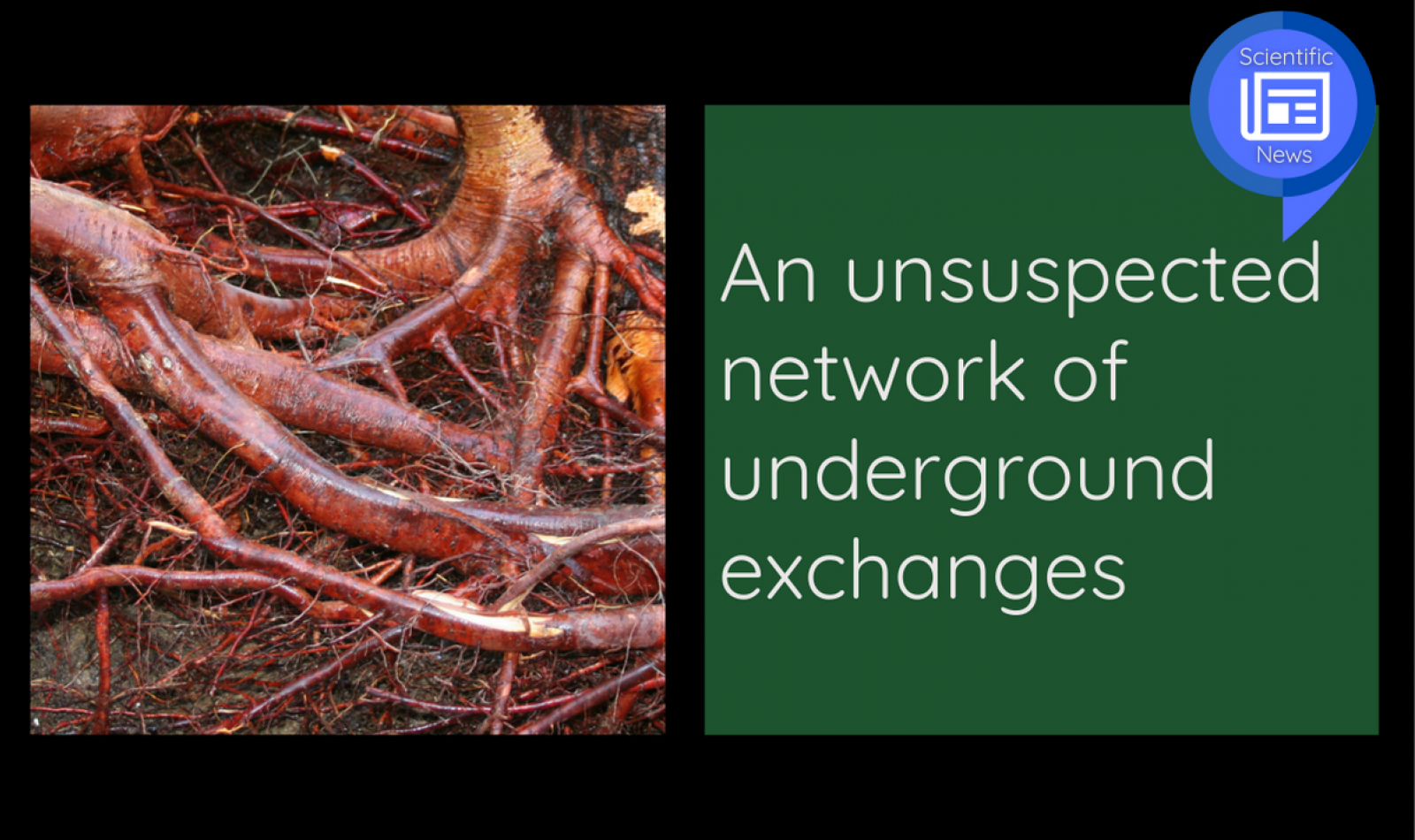
An unsuspected network of underground exchanges
A text by Valérie Levée, science journalist
The subsoil of the forest is much more than a carpet of dead leaves and humus. Beneath the surface, sugars, mineral elements and hormones circulate in a double network of fused roots and ectomycorrhizae, as revealed by the work of Annie DesRochers, a professor at the Institut de recherche sur les forêts of the Université du Québec en Abitibi-Témiscamingue.
The intraspecific network of anastomoses
It was a chance discovery that set the stage for years of research. To see if the decline of aspen trees was related to root disease, Annie DesRochers excavated the soil to examine the roots. Instead of pathogens, she was surprised to find anastomoses, or roots of separate trees that had grafted together. This is not a root that produces suckers from which related trees develop, but two or more trees, initially distinct, whose roots merge. While studies in the mid-20th century described anastomoses as anecdotal phenomena, Annie DesRochers and her team regularly discover them. "We excavate 50m2 plots and we have always found them. Between 30 and 50% of the trees are grafted," she reports. She has observed anastomoses on pine, fir, spruce and poplar trees, both in natural stands and in plantations. They can link up to 5 or 6 trees, sometimes 3 metres apart. The grafts are functional thanks to the formation of common anatomical structures that permit the circulation of nutrients and even hormones.
"Sometimes you see a cut tree that continues to produce growth rings on the stump to close the scar. To produce a ring, you need auxins that are produced in the crown. This suggests that these auxins are transferred from an uncut tree and move up into the stump," describes Annie DesRochers.
It is as if the grafted trees have lost their individuality and become members of the same entity. "We have a single organism made up of several trees that are sustained by the same roots. Photosynthesis takes place in the crowns and the sugars are transported into the common root system. If the conditions are right, the water and sugars will be shared between the individuals," she continues.By studying resource allocation in pairs of grafted trees of different sizes, she found that if the smaller tree is defoliated, it receives sugars from the larger one. But the reverse is also true, if the larger of the two is defoliated, the photosynthetic activity of the smaller tree increases to supply sugars to its larger counterpart.

The word anastomosis describes the physical and functional fusion of the organs of two plants via, in general, the roots. Credit: Elizabeth Turcotte
This sharing allows the grafted trees to better resist insect epidemics or summer droughts, but if resources become limited and the trees compete, the sharing stops. "When conditions are favourable, the surplus goes to the neighbour. If conditions are unfavourable, it is the biggest tree that will draw energy and water to itself and there is no sharing," summarises Annie DesRochers. Just as a single tree self-prunes its lower branches that receive less light, grafted trees react as a single organism and abandon the non-productive parts. Sometimes the graft loses its benefit, as Annie DesRochers has observed in plantations after commercial thinning. When a grafted tree is cut, its root system is kept alive by the uncut grafted partner. Because the ungrafted tree continues to share resources with a tree that no longer exists, its own growth is compromised relative to that of the surrounding ungrafted trees.
The anastomoses brought to light by Annie DesRochers reveal a subterranean network of nutrient sharing, but exchanges are limited between trees of the same species. There is another, broader network, that of ectomycorrhizae.
Interspecific exchanges
Chanterelles, boletes and other cap mushrooms are the external fruiting bodies of ectomycorrhizae. In the soil, these fungi weave a network of mycelium that associates with the roots to live in symbiosis with the trees. The mycelium of ectomycorrhizae penetrates between the root cells, while that of endomycorrhizae penetrates the cells," says Mélissande Nagati, who carried out her doctoral project on ectomycorrhizae under the co-direction of Annie DesRochers. In this symbiosis, "the tree exchanges sugars from photosynthesis for nutrients from the degradation of soil organic matter by the fungus," explains Mélissande Nagati. Ectomycorrhizae have their own preferences and do not associate with just any tree species, but they are generally capable of establishing a symbiosis with several species, just as a tree can be colonised by a procession of several ectomycorrhizae species. A whole network of nutrient circulation is therefore established underground, linking several species of fungi and trees.
But the exchanges are not always equitable and beneficial for all partners, as Mélissande Nagati discovered when she examined the mycorrhizal assemblages associated with balsam fir. Previous studies showed that fir establishes itself better near aspen than black spruce, and the doctoral student wanted to see if the composition of the mycorrhizal community associated with spruce or poplar could explain this difference in fir growth. However, her analyses showed that the culprits were the ericaceous shrubs that grow under the spruce trees. In their presence, not only is the mycorrhizal community different, but the nitrogen nutrition and growth of the firs is reduced. "Relative to its neighbours, the fir tree does not have the same fungal associations and this has a direct impact on its nutrition. One hypothesis is that there are mycorrhizae that are common to both fir and Ericaceae and that the ericaceous shrubs take up what could have gone to the fir," suggests Mélissande Nagati.
This illustrates the complexity and importance of the underground exchange network. "It gives us another vision of soils, which are not only a storehouse but also a place of exchange that guides forest development," concludes Mélissande Nagati.
Information about the researchers

1 - Annie DesRochers is a professor at the Institut de recherche sur les forêts of the Université du Québec en Abitibi-Témiscamingue. She is also co-director of the "Natural Resources" research axis of the Institut nordique du Québec.
2 - Mélissande Nagati did her PhD under the co-direction of Annie DesRochers.
To learn more
Quer, Élodie, Virginie Baldy and Annie DesRochers (2020) « Ecological drivers of root grafting in balsam fir natural stands », Forest Ecology and Management, 475:118388
https://www.sciencedirect.com/science/article/abs/pii/S0378112720311579
Nagati, Mélissande, Mélanie Roy, Annie DesRochers, Yves Bergeron and Monique Gardes (2020) « Importance of Soil, Stand, and Mycorrhizal Fungi in Abies balsamea Establishment in the Boreal Forest » Forests, 11(8)
https://www.mdpi.com/1999-4907/11/8/815
Nagati, Mélissande, Mélanie Roy, Annie DesRochers, Sophie Manzi, Yves Bergeron and Monique Gardes (2019) « Facilitation of balsam fir by trembling aspen in the boreal forest: Do ectomycorrhizal communities matter? » Frontiers in Plant Science, 10.
https://www.frontiersin.org/articles/10.3389/fpls.2019.00932/full
Salomon, Roberto L., Émilie Tarroux and Annie DesRochers (2016) « Natural root grafting in Picea mariana to cope with spruce budworm outbreaks » Canadian Journal of Forest Research, 46(8):1059-1066
https://cdnsciencepub.com/doi/10.1139/cjfr-2016-0121
Tarroux, Emilie and Annie DesRochers (2011) « Effect of natural root grafting on growth response of jack pine (Pinus banksiana; Pinaceae) » American Journal of Botany, 98(6):967-974
https://bsapubs.onlinelibrary.wiley.com/doi/full/10.3732/ajb.1000261
Tarroux, Émilie and Annie DesRochers (2010) « Frequency of root grafting in naturally and artificially regenerated stands of Pinus banksiana: Influence of site characteristics » Canadian Journal of Forest Research, 40(5):861-871
https://cdnsciencepub.com/doi/abs/10.1139/X10-038
 Science News
Science News
Spotlight on Northern Research | An initiative of Institut nordique du Québec
To celebrate Quebec's excellence in northern research and to highlight the various challenges and issues related to these territories, Institut nordique du Québec offers you a series of articles dedicated to the research conducted in its community.
Over the months, you will discover a multidisciplinary research community whose strength lies in the complementary expertise of its members. You will meet individuals who share a strong attachment to the North and who are dedicated to producing, in collaboration with the inhabitants of the region, the knowledge necessary for its sustainable and harmonious development.
You are invited to relay this and subsequent articles to your network, thus enabling the greatest number of people to discover the different facets of northern research and the many faces that animate it. Together for the North

